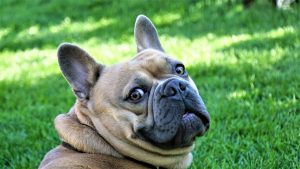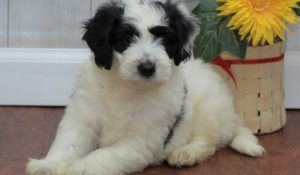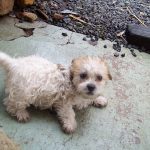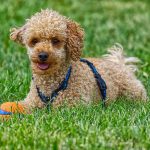Golden Pyrenees is a giant, loving, and affectionate dog, as well as, caring and lovable. To enter the market, the Golden Pyrenees dog is one of the most majestic dogs.
If you plan to get this wonderful Golden mix and look for a complete guide, you are in the right place. This post will get you to know everything about the Golden Pyrenees dog breed, including appearance, temperament, grooming, training, health, and much more.
Let’s find out more about Golden Pyrenees below but first, have a look at the breed profile.
Table of Contents
Golden Pyrenees Breed Profile
| Breed Name | Golden Pyrenees |
| Other Names | Great Pytreiver |
| Origin | United States |
| Dog Breed Type | Crossbreed - Hybrid Breed |
| Parent Breeds | Golden Retriever & the Great Pyrenees |
| Dog Breed Group | Sporting or working |
| Height | 24 - 32 inches |
| Weight | 70 - 120 lbs |
| Life Expectancy | 10 to 13 years |
| Coat Type | Straight, long, dense |
| Colors | Black - Brown - Cream - White - Gray |
| Grooming Needs | Daily brushing needed |
| Hypoallergenic | No |
| Temperament | Excellent |
| Apartment Living | No |
| Kid-Friendly | Yes |
| Pet-Friendly | Yes |
| Health concerns | Hip Dysplasia - Patellar Luxation - von Willebrand's Disease |
| Overall Health | Good |
| Intelligence level | Good |
| Trainability | Excellent |
| Energy Level | Medium |
| Activity | Up to 2 hours daily |
| Litter Size | 7 to 12 puppies |
Related: Irish Doodle Dog Guide
Breed History of Golden Pyrenees
Golden Pyrenees is a mix of two playful and affectionate dog breeds- Golden Retriever and Great Pyrenees. The exact origin and history of the Golden Pyrenees are unknown. Also, the facts and figures about the Golden Pyrenees may vary until the breed is matured.
While we talk about its traits, we need to have a closer look at the parent breeds. For example, the Great Pyrenees is used as a livestock watchdog and is popular for its ability to bark loudly. On the other hand, Golden Retrievers are well known to be ideal family pets that were originally bred to retrieve games. Later they gained popularity as detection working dogs, tracking dogs, and obedience competitors.
Let’s have a quick introduction to the parent breeds.
Quick Introduction to Parent Breeds
Golden Retriever
The Golden Retriever is a Scottish dog breed that is popular for its hunting and retrieving abilities. Lately, they have been used as disability assistance dogs, as well as, search and rescue dogs.
The Golden Retriever is a very friendly and loving dog breed that has an exceptional temperament and that is why when they are crossed with other breeds, the outcome is wonderful. At the moment, the Golden Retriever is among the top 5 dogs for the last many years.
Some other popular Golden crosses are Groodle (crossed with Poodle), Golden Cocker Retriever (crossed with Cocker Spaniel), Goldador (crossed with Labrador), etc.
The Great Pyrenees
The Great Pyrenees or Pyrenean Mountain dog originates from the Pyrenees Mountain and is closely related to the Pyrenean Mastiff. The major difference between both dogs is that the Great Pyrenees is found on the French side of the Pyrenees Mountain while the Pyrenean Mastiff originated on the Spanish side of the Pyrenees Mountain.
These dogs were said to be used by shepherds for protection against bears and wolves. The Great Pyrenees became so popular in the seventeenth century that King Louis XIV of France named it the royal dog of France.
It was imported to the US and Canada in the 1930s and as per AKC, currently, it is the 66th most popular dog breed in the US. Some other popular Pyrenees crosses are the Great Bernese (cross with the Bernese Mountain dog), Pyrador (cross with Labrador), and Saint Pyrenees (cross with Saint Bernard).
Golden Pyrenees Appearance
Golden Pyrenees has a well-proportioned body that is slightly longer than its height. They have a very thick wool-like coat that requires daily brushing.
The Great Pyrenees have almond-shaped brown eyes that make them catchy dogs while their upper lip slightly droops over the lower one.
They have a deep chest with long straight forelegs and a fantastic fluffy tail. The head is rounded with floppy ears while the nose is rich black with wide nostrils. Eyes are deep, expressive, and alert. They have long and robust limbs with well-developed thigh muscles.
Their coat is one of the most appealing physical qualities of the Golden Pyrenees which may be golden with darker brown and black patches of fur.
Temperament and Behavior of Golden Pyrenees
Both the parent breeds, Golden Retriever and the Great Pyrenees have quite different personalities. So it can be tricky to predict the temperament of the Golden Pyrenees. It will be more likely to inherit the gentleness of Golden Retrievers. Along with that, Golden Pyrenees should be energetic and playful and will never say no to a game or other activities.
With their immediate family, Golden Pyrenees are very gentle and friendly. They may not be much social and may take time to be warmer with the people outside of their circle. They have puppy-like enthusiasm even when they are mature like the Great Pyrenees.
Is Golden Pyrenees suitable for families?
Golden Pyrenees is a big dog that requires an owner with great strength. It is a calm dog, but may not be safe for families with young children or infants due to its big size.
Training
Training is necessary if this dog is to adapt to a family because of its large size as it can be unruly without training. Training should start at an early age and it should be consistent so that your fur baby feels more comfortable with its place in the home. One important thing to remember here is that training a Golden Pyrenees dog may not be an easy job if you are not experienced.
Techniques to train this pooch should be a positive reinforcement method so that it enjoys its training. Punishment-based strategies are never suggested. Also, it is recommended to socialize them with other dogs as early as possible as it will help to solve the issue of dominance between dogs.
Grooming
The Golden Pyrenees’ coat is very thick and long. Although it is fluffy and feels lovely to touch, it requires extra grooming. Along with daily brushing, it does require additional maintenance to keep it from matting and tangling.
They need to be bathed once a month or every two months. However, their teeth should be brushed at least twice a week while their nails should be trimmed every 2-3 weeks.
Recommended brushes and grooming tools
Pin brush, comb, nail clipper, and deshedder are the brushes and tools used to groom Golden Pyrenees.
Related: Things not to do while Grooming your Dog
Diet plan for Golden Pyrenees
They need four to five cups of food daily. They have a giant appetite and Kibble is best for them. It is best to consult a veterinarian before you alter the diet of your Golden Pyrenees.
Exercise and activity
Daily exercise is necessary for any large-sized dog and the Golden Pyrenees fulfills these criteria. It will help in maintaining weight. Exercise in a dog park is helpful to socialize with other dogs and people. Some of the most popular and easier exercises include chasing after a ball and tug of war.
Remember one thing, because of their thick coat, the Golden Pyrenees cannot bear the heat, therefore, exercise should be done during the coolest part of the day. Overall, up to 2 hours of mixed activities are recommended for this breed.
Recognized Clubs
The following clubs recognize the Golden Pyrenees breed:
American Canine Hybrid Club
The Designer Breed Registry
The Dog Registry of America
International Designer Canine Registry
The Designer Dogs Kennel Club
Golden Pyrenees puppies
The puppies of Golden Pyrenees proliferate as compared to other dogs. They grow almost 18 inches at three months of age which is incredible. Despite the fact that they are big in size, they are very gentle and playful but not safe with young children. In a single litter, the Golden Pyrenees may have 7 to 12 puppies.
Health-related problems of Golden Pyrenees
There is a wide range of health issues associated with them. Being a large-sized dog, Golden Pyrenees are prone to many health problems. Following are some health problems observed in Golden Pyrenees:
Hip Dysplasia
The signs and symptoms of hip dysplasia are displayed from the sixth month of the pup’s life. In this condition, the dog hesitates to jump, bunny-hop when running and sits with their knees to the side. Unfortunately, this condition runs in generations so it is recommended to ask for the dog’s hip score while getting a puppy from a breeder.
Bloat (or GDV)
It is a devastating condition that can appear suddenly and may kill your dog if left untreated. The cause of the bloat is still unknown. It is more likely to occur in dogs with a deep chest. Symptoms are panting, retching, and a bloated abdomen. If untreated, the animal can pass away within hours. According to a study, 30% of the dogs who developed this disease died.
Osteosarcoma
It is a malignant cancer of the bones. It generally affects the arms and legs and causes severe pain. Cancer can spread quickly around the body. It can be confused with lameness and limb swelling from an injury.
Lifespan
The lifespan of the Golden Pyrenees can be 10 to 13 years. BTW, it is a relatively new crossbreed and it is not easy to predict its lifespan, as well as, other traits and aspects. So, we can say that this lifespan is concluded from the data currently available and may vary.
Recommended read – Utonagan Dog Breed Info










